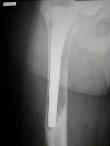(See also: Total Hip Replacement Menu)
Discussion
Examination
- examination for loosening:
- previoius incisions;
- contracture of the flexors and adductors (adds to complexity of the case);
- impingement: tenderness to forced internal rotation may indicate anterior impingement;

- leg-length inequality is noted;
- neurovascular status of the limbs is recorded (EMG can be ordered if necessary);
- trendelenburg gait:
- power of the abductor muscles is noted;
- marked Trendelenburg gait may indicate that abductors are non functional;
- may be due to paralysis or loss of continuity;
- if no trochanteric frx is present, then consider EMG to evaluate for paralysis;
PreOp Planning » (radiographs, equipment, implant selection);
- radiographs
- extraction instruments
- selection of implants:
- rule out infection:
- besides ruling out joint infection, consider culture of nares since preoperative staph aureus nasal carriage is associated w/ postop infection;
- references:
Surgical Approach »
- give prophylactic antibiotics in normal fashion;
- sciatic nerve is identified:
- soft tissue release is extensive so that manual force can be minimal during dislocation;
- partial release of the psoas tendon;
- partial release of gluteus maximus insertion;
- release of reflected head of the rectus femorus;
- references:
surgical dislocation of hip
- because femur usually has been weakened owing to cortical defects or cavitation, great care is taken in dislocating hip and exposing femur to avoid fracture;
- greater trochanter osteotomy will facilatitate dislocation;
- the entire pseudocapsule is excised or released;
need for tissue biopsy cultures from the component membrane interface
- remember that in the case of biofilm, there may be minimal infection in joint fluid and capsule, and the main area of infection will be over the component /bone-membrane interface;
- consider adding tissue culture (or at least saline) to the tissue sample inorder to improve true positive results;
- references:
- A comprehensive microbiological evaluation of fifty-four patients undergoing revision surgery due to prosthetic joint loosening.
- The fate of the unexpected positive intraoperative cultures after revision total knee arthroplasty
- The Chitranjan Ranawat Award: Should prophylactic antibiotics be withheld before revision surgery to obtain appropriate cultures?
- Use of broth cultures peri-operatively to optimise the microbiological diagnosis of musculoskeletal implant infections.
femoral component revision »
acetabular component revision »
- exposure of acetabulum:
- requires wide exposure of hip w/ removal of pseudocapsule, exposing entire proximal end of femur & entire circumference of acetabulum to permit careful implant removal;
- references:
- retention of acetabular shell
- in some revision situations, the acetabular cup is noted to be stable and is left in place (ie only femoral revision is performed);
- references:
- Fate of Cementless Acetabular Components Retained During Revision Total Hip Arthroplasty.
- Cementing a Liner into a Stable Cementless Acetabular Shell: The Double-Socket Technique.
- Cementation of a Polyethylene Liner Into a Metal Shell
- Cementation of a Metal-Inlay Polyethylene Liner Into a Stable Metal Shell in Revision Total Hip Arthroplasty.
- Cementing Acetabular Liners Into Secure Cementless Shells for Polyethylene Wear Provides Durable Mid-term Fixation
- Long-Term Outcomes of Liner Cementation into a Stable Retained Shell: A Concise Follow-up of a Previous Report.
- removal of acetabular components
- grafting of acetabular defects
- management of pelvic discontinuity
Post Op Anesthesia
- Local Analgesia Infiltration Techniques – Hip and Knee Arthroplasty
- Revision total hip arthroplasty
- Long-term results of revision total hip replacement. A follow-up report.
- Multiple revisions for failed total hip arthroplasty not associated with infection.
- Component removal in revision total hip arthroplasty.
- The Fate of Well Fixed Cemented Femoral Components Left in Place at the Time of Revision of the Acetabular Component.
- Results of revision for mechanical failure after cemented total hip replacement, 1979 to 1982. A two to five-year follow-up.
- The Diagnostic and Predictive Value of Hip Anesthetic Arthrograms in Selected Patients Before Total Hip Arthroplasty.
- Fixation of hydroxyapatite-coated revision implants is improved by the surgical technique of cracking the sclerotic bone rim.

